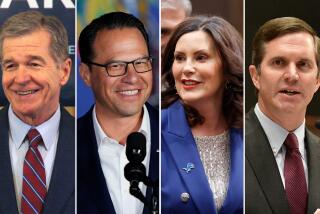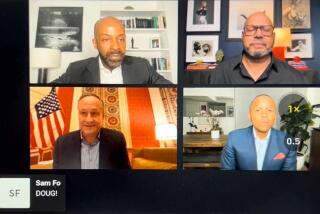COLUMN ONE : Sacrificing Lives, Not Lifestyles : Compared to other major U.S. wars, the conflict in the Gulf has had little financial impact on most Americans. A lengthy conflict, however, could change that.
The Persian Gulf War stands out from other U. S. wars in a vast chasm between the battlefield and the home front: Even as fighting rages, life in America goes on with little apparent sacrifice for most of the public.
Higher taxes do not appear likely, a departure from every major U. S. war this century. Consumers can shop for groceries and other goods unimpeded by special restrictions, unlike World War II. The cost to motorists actually has been going down. Oil, the commodity so central to the Gulf conflict, is glutting the market, and gasoline prices have fallen in recent days.
It may seem ironic to members of the armed forces and their loved ones, but in terms of normal, daily life, “most Americans have not been asked to sacrifice a thing,” declares Robert B. Reich, a political economist at Harvard University’s John F. Kennedy School of Government.
That state of affairs could change, of course. A lengthy war would strain the economy and exacerbate the U.S. budget deficit. Federal Reserve Chairman Alan Greenspan warned recently that if the war lasts longer than three months, the recession will get worse.
Unknowns about the postwar world--the level of terrorist threat, instability in the Middle East and reconstruction costs--threaten a different sort of toll that cannot yet be gauged. War-related anxieties already have eroded the confidence of U.S. consumers, leading to layoffs by auto makers, airlines and other beleaguered employers.
Yet for the moment at least, most Americans don’t really feel the pinch. Odd as it may seem, economists say the U.S. economy has become so colossal, the defense sector so vast, that Americans typically face little inconvenience even as the battle goes on.
“The average person is untouched,” said Martin Anderson, a senior fellow at the Hoover Institution and former domestic and economic policy adviser to President Reagan.
Unlike earlier wars, the United States entered the Gulf battle with a gigantic military arsenal in place, one originally meant for use against the Soviet Union. As a result, there has been no sudden need, say, for auto makers in Detroit to retool factories in a rush to make tanks or airplanes.
Consider the $1.35-million Tomahawk cruise missile, now being fired off U.S. ships toward targets in Kuwait and Iraq.
Since the war began, the United States has launched some 300 Tomahawks, according to the nonprofit Defense Budget Project in Washington. But a big stockpile of the conventionally armed missiles remains--at least 1,200 and perhaps substantially more, said Gordon Adams, director of the organization. Routine purchases, meanwhile, are adding to the inventory.
“By and large, we are not turning to the defense industry and saying, ‘Produce a lot of stuff quickly,’ ” Adams added. A notable exception, he said, is that the military has speeded up production of the Patriot anti-missile missile.
By contrast, the nation marshalled its resources in both world wars, trading consumer convenience for military necessity. In World War I, government officials experimented with new authority over the private economy; such controls were tightened and expanded in World War II.
In the second world war, gasoline, shoes, canned goods, sugar, coffee and other consumer goods were carefully parceled out to the public. Steel that would have been used to construct office buildings was shipped to munitions factories instead. Automobiles and other large consumer products became scarce, as factories hurried to make tanks, battleships and other military equipment.
The buildup transformed the U.S. economy, effectively ending the Great Depression. But it hardly created a consumer paradise.
“We didn’t have much butter--we had guns,” recalled George A. Steiner, a professor emeritus at UCLA’s John E. Anderson Graduate School of Management, who served on the staff of the powerful War Production Board in World War II.
Also, for all the nostalgia about America’s national effort, the drive to divert resources from consumers to the military was not a smooth one.
At first, the auto industry stuck to its priority of making cars. In 1941, U.S. auto makers manufactured almost 1 million more vehicles than they had in 1939, according to Richard Polenberg, a history professor at Cornell University. Gradually, however, federal officials asserted their authority throughout private industry.
“Manufacturers switched from making shirts to mosquito netting, from model trains to bomb fuses, from metal weather-stripping to mortar shells and from kitchen sinks to cartridge cases,” Polenberg wrote in his 1972 book, “War and Society.”
Several years later, during the Korean War, controls were imposed over the civilian economy once more. While less pervasive than in World War II, the limits again cut into construction and auto production, said Steiner, who helped oversee the rules as an official in the Truman Administration.
From a broad perspective, inconveniences to U.S. consumers have been minor compared to the grueling sacrifices that other countries have endured in wartime.
Walt W. Rostow, an economic historian who served in the administrations of John F. Kennedy and Lyndon Johnson, recalls a film he watched during World War II, while on a visit to besieged Britain.
The film’s narrator was advising Americans that they could still bake their own chocolate cake--and circumvent sugar quotas--by melting down chocolate bars. To a British audience used to German bombing raids, the notion of Americans worrying about dessert seemed absurd.
“The economic hardships in the wars of the 20th Century have not been that great for the United States,” said Rostow, a professor at the University of Texas in Austin who was a close adviser to Johnson during the Vietnam War. “There have been no real shortages of food in this country or great suffering.”
Few would suggest that the Gulf War yet requires major sacrifices by consumers--although Americans may be tempering their appetite for oil due to the conflict.
In a national survey conducted Jan. 22-29 for Citibank, three out of four respondents said that Americans should cut back their use of oil and gasoline; a slightly higher number said they had begun to conserve energy. Seven out of 10 agreed that it was appropriate to cut back on luxury items, half favored reducing vacations and more than one-third suggested less entertaining and dining out.
Still, two out of three said the Persian Gulf War had prompted little change in their personal spending habits overall.
“At this point, the war has had less of a financial impact on people than I would have imagined,” said Douglas E. Schoen, a partner at Penn & Schoen, the private research firm that conducted the survey for Citibank MasterCard and Visa.
Some contend that if the public were asked to reach deeper into its pockets to pay for the war--or if other personal sacrifices were required--support for the effort would decline. President Bush already has said he will not ask for a tax increase to finance Operation Desert Storm, just as he pledged not to institute a draft.
“I don’t think the Administration yet dares to suggest general sacrifice to the American people, because I think support for the war, while widespread, is quite thin,” said John Morton Blum, a historian at Yale University.
The public appears deeply divided on the question of war taxes. A CBS poll taken Jan. 27 and 28 found that 50% of the public would be willing to pay higher taxes to underwrite a war and 44% would not. A slight majority of respondents favored a tax on imported oil, while most rejected new taxes on income or gasoline.
If the Gulf War is waged without a tax boost, however, it will be the exception. All major U.S. wars in this century were accompanied by tax increases, sooner or later.
To help pay for World War I, government officials chose, in effect, to soak the rich.
The tax rate for the elite earning above $1 million a year was pushed up more than tenfold to 77%, according to Michael A. Schuyler, senior economist with the Institute for Research on the Economics of Taxation. Less affluent taxpayers also were affected, as the exemption for a single individual was slashed from $3,000 to $1,000.
And that was just the beginning.
“The income tax did not become a middle-class tax until World War II,” Schuyler said.
In that war, the tax collector for the first time reached directly into people’s paychecks, with the introduction of withholding. Exemptions also were reduced, and tax rates were boosted. By 1944, the lowest tax rate had jumped to 23% from a level of 10% just a few years earlier.
Taxes also were raised during the Korean War and, ultimately, the Vietnam War. President Johnson resisted the latter move for years, seeking to finance both the war and a huge expansion in social welfare programs essentially by printing more money.
Johnson finally asked Congress to approve a tax boost lasting for two years “or for so long as the unusual expenditures associated with our efforts in Vietnam continue.” Americans paid a special 5-10% war surtax in 1968 and 1969.
Many scholars viewed that measure as too little too late to bail out the U.S. economy; government spending during the Vietnam years is often cited as one of the root causes of inflation in the 1970s.
“The government lacked the courage to finance the war through taxation, so they financed it through inflation,” maintains Stephen S. Cohen, co-director of UC Berkeley’s Roundtable on the International Economy. “Now we may be doing the same thing.”
Just as individuals seem to be enduring the Gulf War with little economic sacrifice, some experts argue that the war should exert only a moderate strain on the huge U.S. economy, unless the allied quest takes a drastic turn downhill.
These analysts say that estimates of the net cost to the United States--varying from as little as $15 billion to more than $50 billion--reflect a manageable burden for America’s $5.6-trillion economy, the nation’s budget deficit notwithstanding.
Even a price tag of $100 billion for the Gulf War, larger than most estimates, would represent less than 2% of the U.S. gross national product, the nation’s annual economic activity.
To put that in perspective, the financial cost of World War II came to almost twice the amount of a single year’s GNP at the time, said Anderson, the former Reagan adviser. World War I cost 43% of a year’s GNP; Korea cost 15% and Vietnam cost 14%.
The Gulf War is likely to be “the least expensive war in American history,” Anderson said, pointing out that a stable peace would benefit business and the economy. “In terms of the past wars we’ve fought, the cost isn’t even close.”
But what does that really mean? A whole range of costs, some invisible and others played down by U. S. leaders, could mean that Americans will sacrifice more than they are bargaining for in the Gulf War.
The occupation and reconstruction of postwar Iraq, heightened anti-terrorist efforts, added foreign aid and higher energy costs will greatly push up the real price of war paid by Americans, according to a new study by Public Citizen, a consumer group in Washington that favors raising taxes to finance the war.
“So far, discussion of costs has focused too narrowly on the troop deployment and the war effort itself,” said James P. Love, a private economist who wrote the report. He concluded that an average family of four ultimately will pay between $2,624 and $4,288 to cover the direct and indirect costs of the war.
Some ask another question altogether: If the U.S. budget indeed can absorb a multibillion-dollar jolt to pay for the war, they say, why can’t the nation afford to give a greater share of its wealth to peaceful priorities?
“People are making the argument that we can’t afford to do anything in this country in terms of meeting human needs,” said Robert Dreyfuss, a spokesman for Public Citizen. It “strains credibility,” he maintained, to make such an argument while also saying that the war cost is easily handled.
Experts of diverse political persuasions warn that the war will worsen a U.S. budget deficit--a deficit piled up, in part, through the years of heavy defense spending that readied America for war. The red ink may exceed $300 billion this year, and if the war drags on, the public will pay in a variety of ways, argues Harvard’s Reich.
One consequence would be higher interest rates, due to the need to attract the foreign investors who help finance the federal deficit. Such increased interest payments would put a squeeze on the U.S. resources available for important non-military needs, such as unemployment insurance, education, highways and research.
“Most Americans don’t know that of every dollar they hand over to the federal government, about 15 cents is now going to foreigners as interest charges--and that is increasing,” Reich said.
In a sense, such deficit-financing means that the United States has yet to pay for the war--except on the field of battle.
“Americans are spending lives,” said Barry P. Bosworth, an economist at the Brookings Institution in Washington. “They’re not spending money.”
More to Read
Get the L.A. Times Politics newsletter
Deeply reported insights into legislation, politics and policy from Sacramento, Washington and beyond. In your inbox three times per week.
You may occasionally receive promotional content from the Los Angeles Times.






